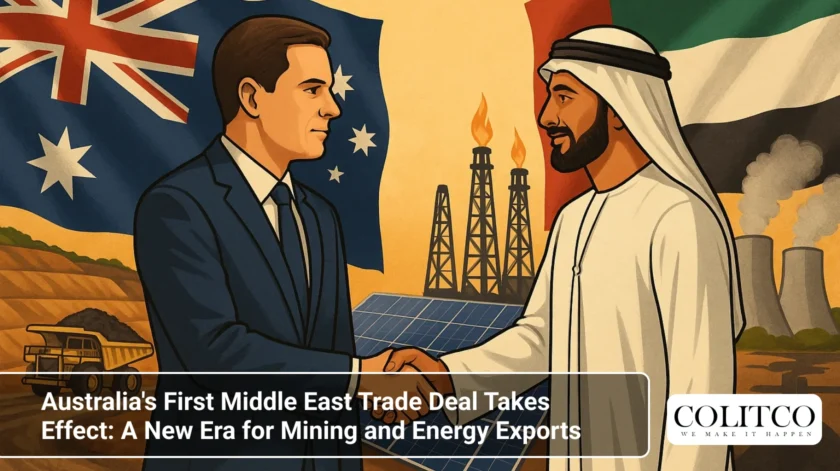Australia has officially opened a new chapter in its international trade relations as its first-ever Middle East free trade agreement took effect on 1 October 2025. The landmark Australia-UAE Comprehensive Economic Partnership Agreement (CEPA) with the United Arab Emirates promises to reshape export flows worth billions.
The deal arrives at a crucial moment. With Australia’s gold output hitting 300 tonnes in 2025, mining exports are generating record revenues. The UAE agreement offers a strategic gateway to expand these gains across the broader Middle East region.
What’s in the Australia-UAE Trade Deal?
The figures tell a compelling story. Two-way trade between Australia and the UAE reached $18.5 billion in 2024, making the UAE Australia’s largest trade and investment partner in the Middle East.
Australian produce is the best there is, I want to see it shared with the world.
We’ve been working hard to diversify our trading relationships – on the 1st of October our free trade agreement with UAE kicks in.
It’s fantastic news for Australian producers, workers and for our… pic.twitter.com/k4GKJy7qDN
— Anthony Albanese (@AlboMP) September 29, 2025
Once fully implemented, the agreement will eliminate tariffs on over 99% of Australian exports to the UAE. First-year savings for farmers, miners, and manufacturers are estimated at $278 million, with total tariff savings rising to $240 million annually once fully phased in.
Independent modelling projects an additional $1.02 billion worth of Australian goods will flow to the UAE each year. That’s a significant boost for exporters already benefiting from strong commodity prices.
Mining Sector Set to Gain
Australian mining companies stand to benefit substantially. The UAE’s tariff elimination covers key export categories including:
- Alumina
- Iron ore concentrates
- Steel products
- Copper and zinc materials
- Processed mineral commodities
The removal of import duties makes Australian mineral products more price-competitive against suppliers from other regions. Given global demand for critical minerals driving supply chain changes, this timing couldn’t be better.
Australia’s Minister for Trade and Tourism, Senator Don Farrell, emphasised the strategic importance. “As an important global logistics centre and hub, the UAE will serve as a gateway for Australia’s exports to the broader region and beyond,” he stated in the official government announcement.

Senator Don Farrell, Australia’s Minister for Trade and Tourism
Agriculture and Food Exports
Beyond minerals, Australian farmers are celebrating. The agreement eliminates tariffs on 99% of agricultural exports to the UAE.
Red meat exporters, who already ship $895 million worth of product annually to the UAE, will see immediate duty-free access. Dairy, grains, wine, and premium food products also benefit from tariff elimination or phased reductions.
The UAE is Australia’s 11th largest agriculture export market, with $2.55 billion in exports during FY2023-24. With a growing expatriate population and thriving tourism sector, demand for premium Australian food continues rising.
Investment Flows and Sovereign Wealth
The CEPA isn’t just about goods. Investment provisions in the agreement aim to attract some of the world’s largest sovereign wealth funds to Australian projects.
Priority sectors identified include:
- Renewable energy infrastructure
- Digital technology and data centres
- Agricultural production and processing
- Mining and mineral processing
Two-way investment stock between the nations already sits at $31 billion as of 2023. The agreement provides greater certainty and protection for investors on both sides.
Services and Professional Access
Australian service providers gain improved market access across more than 120 sectors. Professional services, financial services, education, and digital services all feature prominently.
For the mining services sector, which generates billions in export revenue through technology and consulting, the UAE agreement opens doors to a broader regional market.
The UAE’s position as a Middle East business hub means Australian firms establishing operations there can service clients across the Gulf Cooperation Council region.
Sustainability and First Nations Trade
The agreement breaks new ground with its dedicated chapter on sustainable agriculture and food systems. It’s the first Australian trade agreement to include such provisions.
Another first: a dedicated chapter establishing a framework for cooperation on First Nations trade and investment interests. This acknowledges the growing importance of Indigenous business participation in international trade.
Labour provisions affirm commitments to eliminate forced labour and address workplace safety and discrimination.
Timeline to Implementation
Key dates in the agreement’s development:
- 13 December 2023: Negotiations commenced
- 17 September 2024: Negotiations concluded
- 6 November 2024: Agreement signed in Canberra
- 12 February 2025: Joint Standing Committee on Treaties recommended ratification
- July 2025: Implementing legislation passed Parliament
- 1 October 2025: Agreement entered into force
Industry Response
Early reactions from industry have been positive. Freight and logistics operators are preparing for increased cargo volumes.
Digital logistics companies are upgrading systems to handle new customs procedures. The CEPA includes provisions for electronic trade documents, e-signatures, e-invoicing, and e-payments to streamline border processes.
Mining equipment, technology, and services (METS) companies see opportunities to expand into UAE-based operations serving regional mining projects.
Strategic Context
The agreement aligns with Australia’s broader trade diversification strategy. Following free trade agreements with India (2022) and the UK (2023), the UAE deal represents continued momentum in opening new export markets.
Given ongoing trade tensions affecting global supply chains, diversifying trading partners reduces risk and creates options for Australian exporters.
The UAE’s strategic location between Europe, Africa, and Asia makes it an ideal distribution hub for Australian products targeting multiple markets.
Future Targets
UAE Minister of State for Foreign Trade Dr. Thani bin Ahmed Al Zeyoudi set an ambitious target. He aims to triple bilateral non-oil trade from $6.3 billion in 2024 to $15 billion by 2032.
To support this growth, both nations agreed to enhance cooperation on trade facilitation, customs procedures, and market access issues through regular ministerial-level consultations.
What’s Next?
With the agreement now in force, attention turns to implementation. Australian exporters must familiarise themselves with:
- New preferential tariff rates and schedules
- Rules of origin requirements for claiming preferences
- Updated customs documentation procedures
- Services market access commitments
The Department of Foreign Affairs and Trade website provides detailed guidance for businesses looking to take advantage of the new arrangements.
Australian businesses with export-ready products and services should assess opportunities in the UAE market. With preferential access now secured, the timing favours early movers who can establish market presence and brand recognition.
The historic nature of this agreement signals Australia’s commitment to expanding its Middle East trade footprint beyond the UAE to potentially include other regional partners in future deals.
Also Read: Beijing Orders Total Freeze on BHP Iron Ore Shipments in Price War Escalation
FAQs
1.When did the Australia-UAE trade agreement take effect?
The Australia-UAE Comprehensive Economic Partnership Agreement entered into force on 1 October 2025, following the completion of all necessary legislative and treaty processes in both countries.
2.What are the main benefits for Australian exporters?
The agreement eliminates tariffs on over 99% of Australian exports to the UAE, saving exporters $278 million in the first year. It also improves market access for services and creates certainty for investors.
3.Which Australian industries benefit most from this deal?
Mining, agriculture, food and beverage, professional services, education, and financial services are the primary beneficiaries. Red meat, dairy, minerals, and wine exports gain immediate duty-free access.
4.How does this agreement affect Australian mining exports?
Mining products including alumina, iron ore, steel, copper, and zinc materials will enter the UAE duty-free, making Australian minerals more price-competitive in the Middle East market.
5.Is this Australia’s first trade agreement with a Middle East country?
Yes, the UAE agreement is Australia’s first comprehensive free trade agreement with any country in the Middle East or North Africa region.












